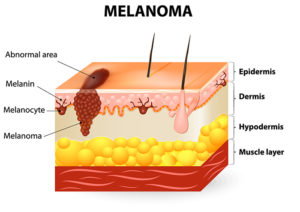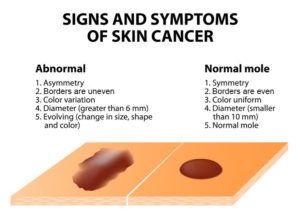
Summer in Maine usually means a lot of time spent on the beach and participating in outdoor activities. This is the time that taking sun safety measures can’t be overdone. The obvious reason is that overexposure to the sun can lead to skin cancer. In fact, based on 2014 CDC data, Maine is among the states that rank highest in U.S. melanoma deaths and our melanoma incidence rate is higher than both California and Florida! Being “hardy Mainers” who see the sun only a few months out of the year, it’s quite possible that we just don’t take it seriously. The numbers prove that our propensity to shrug it off could have dire consequences.
The Stages of Melanoma
 Skin cancer isn’t just confined to your skin, as the name may imply. As most cancers, the skin is merely the starting place and its severity develops in stages.
Skin cancer isn’t just confined to your skin, as the name may imply. As most cancers, the skin is merely the starting place and its severity develops in stages.
- Stage 0: The malignant tumor is localized in the epidermis – the upper layer of the skin.
- Stage I: The tumor is still localized but is up to 2mm thick and has entered the dermis.
- Stage II: the tumor is still localized but has increased in size and has developed an ulceration at the top. The depth of the tumor determines the severity of this stage (subclasses IIA, IIB, and IIC)
- Stage III: The tumor has spread to regional lymph nodes. The level of lymph nodes involved determines the severity of the stage (stages IIIA, IIIB, and IIIC)
- Stage IV: The tumor has spread outside of the regional lymph nodes to other areas of the body including distant lymph nodes, vital organs, and soft tissues. Brain metastases is one of the most common and hard-to-treat forms of Stage IV melanoma.
Your risk of developing it increases with your first serious burn. So, it’s incredibly important to start your kids on sunscreen as soon as they start spending time in the sun. When they’re old enough, make sure they know why it’s important so they eventually choose to do it on their own. And just because you’re no longer a child, does not mean it’s too late. Continued exposure increases your risk, so keep on applying!
Detection is in Plain Sight
Skin cancer is one of the only cancers you can actually see as it develops. Take advantage of that by checking your skin for abnormalities on a regular basis. Enlist the help of your doctor and partner if you have one and know your ABCDEs: the warning signs of melanoma.
B – Border. Benign moles have smooth, even borders. Borders on a melanoma tend to be uneven.
C – Color. Benign moles are typically one color. Look for moles that are made up of a number of different colors or shades.
D – Diameter. Benign moles are smaller in diameter. Melanomas are typically larger than a quarter inch or the size of a pencil eraser.
E – Evolving. Benign moles look the same over time. If a mole starts to evolve/change in size, color, shape, elevation or if bleeding, itching or crusting develops, see a doctor.
Getting yearly physicals is an important part of catching sun cancer early because most doctors will look at your skin for the signs above. If they don’t, ask them to. It could mean the difference between a quick incision to remove a localized Stage 0 tumor or major surgeries, chemotherapy, etc. under treatment of Stage IV cancer.
Prevention Tips
- Wear sunscreen of SPF 30 or higher
- Wear UV-blocking sunglasses
- Wear UV protective clothing. Coolibar and Columbia are among companies that offer numerous options.
- Avoid spending time in the sun between the hours of 10:00 am and 4:00 pm.
- Check your area’s UV Index and follow the EPA’s scale below accordingly. You can find your area’s UV forecast on sites such as The Weather Network or download the EPA’s SunWise UV Index app for either iPhone or Android devices.
- Avoid places with bright surfaces such as sand, water, and snow which reflect UV and increase exposure. If you can’t avoid them, take extra precaution against exposure.
- Avoid tanning and never use tanning beds.
- Know if your medications increase your skin’s sensitivity to sunlight.
EPA’s UV Index Scale
The UV Index scale below conforms with international guidelines that were established by the World Health Organization. Find the guide at https://www.epa.gov/sunsafety/uv-index-scale-1.
| UV Index Number | Exposure Level | Time to Burn | Actions to Take |
| 0-2 | Low | 60 minutes | Low risk of harm from unprotected sun exposure for the average person.
|
| 3-5 | Moderate | 45 minutes | Moderate risk of harm from unprotected sun exposure.
|
| 6-7 | High | 30 minutes | High risk of harm from unprotected sun exposure. Protection against skin and eye damage is needed.
|
| 8-10 | Very High | 15-25 minutes | Very high risk of harm from unprotected sun exposure. Take extra precautions because unprotected skin and eyes will be damaged and can burn quickly.
|
| 11 or more | Extreme | 10 minutes | Extreme risk of harm from unprotected sun exposure. Take all precautions because unprotected skin and eyes can burn in minutes.
|
Find today’s UV index for your area by entering your zip code or city and state in the box below.
Resources
- EPA’s UV Index Scale: https://www.epa.gov/sunsafety/uv-index-scale-1
- EPA’s SunWise Mobile app: iTunes | Android
- You can find a wealth of information on skin cancer and melanoma from the Skin Cancer Foundation and the Melanoma Research Foundation
- Melanoma Facts and Stats from the Melanoma Research Foundation




